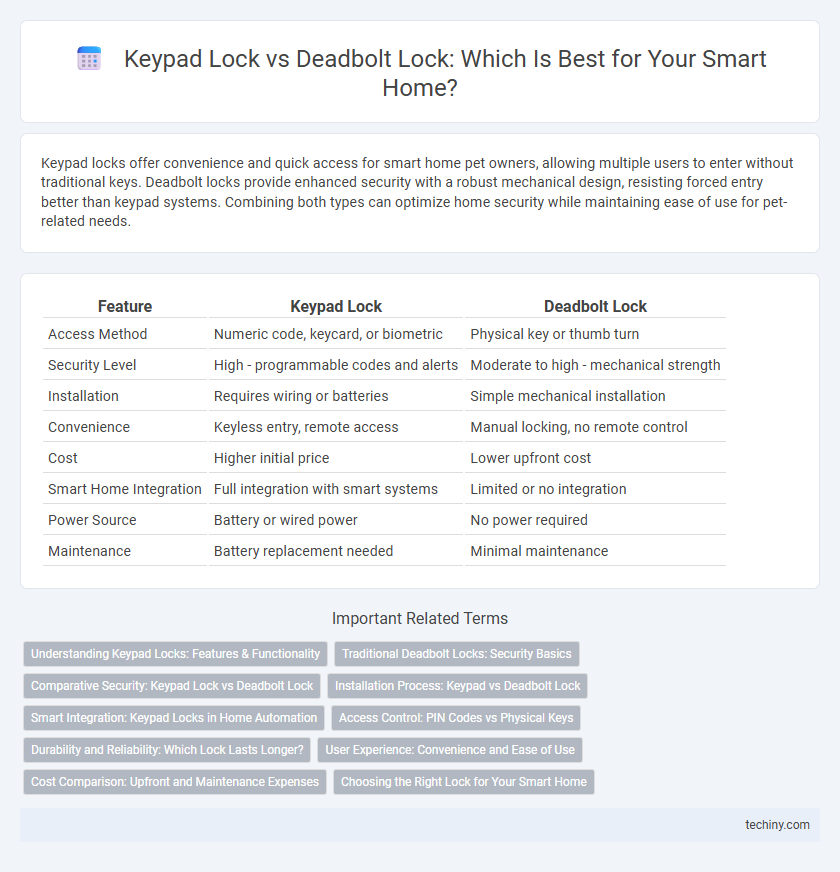Keypad locks offer convenience and quick access for smart home pet owners, allowing multiple users to enter without traditional keys. Deadbolt locks provide enhanced security with a robust mechanical design, resisting forced entry better than keypad systems. Combining both types can optimize home security while maintaining ease of use for pet-related needs.
Table of Comparison
| Feature | Keypad Lock | Deadbolt Lock |
|---|---|---|
| Access Method | Numeric code, keycard, or biometric | Physical key or thumb turn |
| Security Level | High - programmable codes and alerts | Moderate to high - mechanical strength |
| Installation | Requires wiring or batteries | Simple mechanical installation |
| Convenience | Keyless entry, remote access | Manual locking, no remote control |
| Cost | Higher initial price | Lower upfront cost |
| Smart Home Integration | Full integration with smart systems | Limited or no integration |
| Power Source | Battery or wired power | No power required |
| Maintenance | Battery replacement needed | Minimal maintenance |
Understanding Keypad Locks: Features & Functionality
Keypad locks provide keyless entry through numeric code input, enhancing convenience and security for smart home access control. These locks often feature programmable user codes, temporary access options, and real-time entry logs compatible with home automation systems. Integration with Wi-Fi or Bluetooth connectivity allows remote locking, unlocking, and monitoring via smartphone apps, streamlining smart home management.
Traditional Deadbolt Locks: Security Basics
Traditional deadbolt locks provide robust security by using a solid metal bolt that extends deeply into the door frame, making forced entry more difficult. These locks typically feature a single cylinder mechanism operated by a key from the outside and a thumb turn from the inside for quick egress. Widely recognized for their durability and resistance to lock picking, deadbolt locks remain a fundamental choice for securing residential doors in smart home setups.
Comparative Security: Keypad Lock vs Deadbolt Lock
Keypad locks offer enhanced access control through customizable codes and audit trails, reducing risks associated with lost or stolen keys compared to traditional deadbolt locks. Deadbolt locks provide robust physical security with strong resistance to forced entry and are less vulnerable to electronic hacking. Combining both keypad and deadbolt locks can maximize home security by integrating electronic access management with mechanical strength.
Installation Process: Keypad vs Deadbolt Lock
Keypad locks offer simplified installation procedures, often requiring minimal tools and no wiring, making them highly suitable for DIY projects. Deadbolt locks typically involve a more complex installation process, including aligning strike plates and drilling precise holes, which may necessitate professional assistance. Evaluating ease of installation is crucial when choosing between keypad locks and deadbolt locks for smart home security upgrades.
Smart Integration: Keypad Locks in Home Automation
Keypad locks offer seamless smart integration within home automation systems, allowing users to control access remotely via smartphone apps and voice assistants like Alexa or Google Home. These locks provide customizable access codes, enabling temporary or scheduled entry for family members and service providers without physical keys. Compared to traditional deadbolt locks, keypad locks enhance security through real-time alerts and activity logs, ensuring comprehensive monitoring of home entry points.
Access Control: PIN Codes vs Physical Keys
Keypad locks offer enhanced access control through customizable PIN codes, allowing multiple users to have unique entry credentials without the need for physical keys. Deadbolt locks rely on physical keys, which can be lost or duplicated, potentially compromising security. Smart home systems often integrate keypad locks for remote access management and real-time entry monitoring, improving overall security compared to traditional deadbolts.
Durability and Reliability: Which Lock Lasts Longer?
Deadbolt locks are renowned for their superior durability due to solid metal construction and resistance to physical attacks, making them a long-lasting security solution for smart homes. Keypad locks, while offering convenience through digital access, often incorporate electronic components that may be susceptible to wear and require occasional maintenance or battery replacement. For homeowners prioritizing longevity and minimal upkeep, deadbolt locks generally provide a more reliable and durable option compared to keypad locks.
User Experience: Convenience and Ease of Use
Keypad locks offer enhanced convenience through keyless entry, allowing users to unlock doors quickly using customizable PIN codes, which reduces the hassle of carrying physical keys. Deadbolt locks provide robust security but require manual locking and key management, which may be less convenient for frequent access. Smart keypad locks often integrate with home automation systems, enabling remote control and real-time access monitoring, significantly improving ease of use and user experience.
Cost Comparison: Upfront and Maintenance Expenses
Keypad locks generally have a higher upfront cost, ranging from $100 to $300, compared to traditional deadbolt locks, which typically cost between $20 and $60. Maintenance expenses for keypad locks can include battery replacements and potential electronic repairs, while deadbolt locks usually require minimal upkeep, mostly limited to occasional lubrication and key duplication. Over time, keypad locks may incur higher overall expenses due to technology upkeep, whereas deadbolt locks remain more cost-effective for basic security needs.
Choosing the Right Lock for Your Smart Home
Keypad locks offer keyless convenience and remote access, making them ideal for smart homes seeking seamless integration with automation systems. Deadbolt locks provide robust mechanical security and are often recommended for primary entry points due to their resistance to forced entry. Selecting the right lock depends on balancing technological features like app control and biometric options with traditional safety needs and lock compatibility with existing smart home ecosystems.
Keypad Lock vs Deadbolt Lock Infographic

 techiny.com
techiny.com